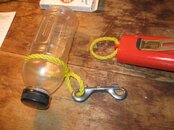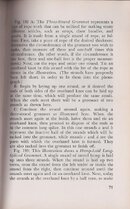Maxime-Thierry Lavoie
Registered
Hi everyone,
I’m submitting this idea to the Sidemount diving community for feedback and your ideas on possible improvements. I’m trying to improve upon the concept of the tank lanyard / ring bungee system. I want to share my thoughts with everyone so we all benefit. Sort of like crowd-sourcing a solution. Please comment in this spirit as I’m very eager to learn from your experience and gather your constructive criticism.
I apologize in advance for the long-winded post. I want to be as precise and clear as possible in my objectives and the possible solution. Also please forgive me if this has already been discussed in the past. I simply have not found any evidence of it so far and so I’m just putting it out there.
The Challenge:
The Possible Solution:
I use a length of 550 parachute cord and tie it into a loop using a Double Fisherman’s bend. I then wrap this loop around the tank’s neck and secure it with a small Quick Link (1.5 in | 3.8 cm). The length of the cord is adjusted so that the loop and Quick Link are sufficiently able to move around the neck of the valve but are not too long as to protrude more than a couple of inches when taught. I then attach one end of a Medium Double-Eye Bolt Snap (4 in | 10 cm) to the Quick Link (see images below). The other end of the bolt snap will be clipped to the shoulder d-ring.
The idea is to clip the tanks to the harness, route the hosing, prep for entry, then once in the water, unclip the bolt snaps completely and stow them somewhere. I like the butt d-ring but where you stow them is completely up to you. You then loop the bungees around the tanks and off you go. You can do this when you feel comfortable: right away on the surface before going down, immediately after submerging while hovering in place (S drill anyone?) or after you’ve descended to the bottom. Just do it when you feel secure enough that you are not task loading yourself such as during the descent (clearing your ears, working your BCD, holding the line, etc).
Coming back up, you do the reverse. Only this time using all the time you need during your 3 minute safety stop. While practicing, I could undo the bungee, fetch the clip, clip it to the Quick Link and then the shoulder d-ring in about 10-15 seconds for each tank (I’m sure you guys can best this time!).
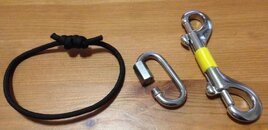
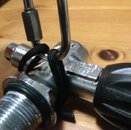
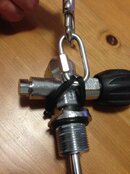
Note that you could chose to use a different length of Double-Eye bolt snap length to adjust the distance that the tank hangs from the d-ring when walking. I found that, for my size, I like the medium length (4 in) but some could go for a shorter (3.5 in) or longer (4.5 in) version. You could also adjust the length of the paracord but that would mean the Quick Link might dangle too much if you lengthen the cord. The Quick Link can also be of smaller size if desired. It all comes down to personal preference here.
The Negative Points:
The Positive Points:
The Testing:
I’ve tested this set up in a few pool dives and so far I really like it. Its cold in Canada right now so I’ll be testing it more fully on an upcoming trip to the Bahamas (Blackbeard’s Cruises) where I'll dive from a boat 3-4 times a day. I’ll report back of its practicality after this trip mid next month.
Comments?
In the mean time, I invite others to try this out and give me feedback and your ideas on improvements. I would very much like to hear them.
Cheers!
Max
I’m submitting this idea to the Sidemount diving community for feedback and your ideas on possible improvements. I’m trying to improve upon the concept of the tank lanyard / ring bungee system. I want to share my thoughts with everyone so we all benefit. Sort of like crowd-sourcing a solution. Please comment in this spirit as I’m very eager to learn from your experience and gather your constructive criticism.
I apologize in advance for the long-winded post. I want to be as precise and clear as possible in my objectives and the possible solution. Also please forgive me if this has already been discussed in the past. I simply have not found any evidence of it so far and so I’m just putting it out there.
The Challenge:
- I often dive from boats or from difficult shore entries. The water is often choppy and its oftentimes not possible to pass bottles to/from the boat for exit/entry. An equipment line is also not always possible on some charters I use.
- I prefer a hard point of attachement at the top of the tank rather than relying on the bungees to support the upper part of the tank for entries and exits (most useful for ladder climbs). That way, if you fall back into the water, the tanks have less chance to detach and dangle. Also, a hard point of attachement reduces the bouncy-ness effect when walking compared to relying on the bungees.
- I like to use loop bungees because they give me the best results for tank trimming and they ensure the tank valve stays where I want them. This means ring bungees are out of consideration (at least for this topic as I have used them while ice diving).
- I don’t like the “regular" tank lanyard that stays clipped. Once you loop the bungee, the lanyard dangles a bit and you have a piece of string that is sometimes just in the way. Unclipping the lanyard would mean the clip would hang loose and dangle 4-5 inches from the valve and thats not something I want.
- I don’t want the hard attachement to be permanent (fully metal on metal) and I want it to be easily cut in case of an emergency.
- I want something easily transferable to other tanks so that it works while travelling as well.
- I’m not looking for a cave-worthy solution. This is mostly for open water scenarios.
- I want this solution to be as inexpensive as possible. Lets face it, dive gear is expensive, if you can have a simple, cheap solution its more money left to spend on diving toys.
- Most importantly is the fact that in the water, my goal is to have things as simple, tidy, less crowded as possible. This means minimizing D-ring usage (a lanyard is one more clip on a shoulder d-ring), hoses with tight routing, lanyards crossing hoses, etc.
The Possible Solution:
I use a length of 550 parachute cord and tie it into a loop using a Double Fisherman’s bend. I then wrap this loop around the tank’s neck and secure it with a small Quick Link (1.5 in | 3.8 cm). The length of the cord is adjusted so that the loop and Quick Link are sufficiently able to move around the neck of the valve but are not too long as to protrude more than a couple of inches when taught. I then attach one end of a Medium Double-Eye Bolt Snap (4 in | 10 cm) to the Quick Link (see images below). The other end of the bolt snap will be clipped to the shoulder d-ring.
The idea is to clip the tanks to the harness, route the hosing, prep for entry, then once in the water, unclip the bolt snaps completely and stow them somewhere. I like the butt d-ring but where you stow them is completely up to you. You then loop the bungees around the tanks and off you go. You can do this when you feel comfortable: right away on the surface before going down, immediately after submerging while hovering in place (S drill anyone?) or after you’ve descended to the bottom. Just do it when you feel secure enough that you are not task loading yourself such as during the descent (clearing your ears, working your BCD, holding the line, etc).
Coming back up, you do the reverse. Only this time using all the time you need during your 3 minute safety stop. While practicing, I could undo the bungee, fetch the clip, clip it to the Quick Link and then the shoulder d-ring in about 10-15 seconds for each tank (I’m sure you guys can best this time!).



Note that you could chose to use a different length of Double-Eye bolt snap length to adjust the distance that the tank hangs from the d-ring when walking. I found that, for my size, I like the medium length (4 in) but some could go for a shorter (3.5 in) or longer (4.5 in) version. You could also adjust the length of the paracord but that would mean the Quick Link might dangle too much if you lengthen the cord. The Quick Link can also be of smaller size if desired. It all comes down to personal preference here.
The Negative Points:
- The main disadvantage is task loading. Its one more thing to take care of during the dive.
- Double-Eye clips could be dropped if not handled properly.
- In very cold water diving with thick gloves, it might be hard to find the Quick Links. This could be solved by using larger links. Testing is needed.
- I have not considered this solution as being viable for more than 2 tanks. I lack the training and experience to do so. If you want to, feel free to experiment and let us know of your findings. Know that it was not my gaol to have a solution that works for more than 2 tanks.
- There is a chance that the Quick Link rubs a bit on the valve and so might scratch it long term.
- Having the paracord wrapped around the tank neck means that you could possibly get your finger in the wrap whilst trying to undo the bungee. Some small amount of practice is required to undo the bungee without tugging at the paracord. It can be argued that this is also the case of a regular tank lanyard if unclipped.
The Positive Points:
- The paracord can be cut in event of an emergency.
- The Quick Link does not dangle beyond the valve’s knub so there is less chance of snagging it compared to an unclipped tank lanyard.
- Parachute cord is very very strong and will not be affected by salt water.
- This solution is cheap! About 14$ (1$ for the Quick Link, 5$ for the Bolt Snap, 1$ for the paracord length for each side) compared to the 130$ of gearing up with ring bungees (25$ for the ring bungee 40$ stage kit for each side).
- The solution is very light. Good for travel.
- Set up is very fast so it only adds a minute or two to your setup time. If you use your own tanks, you just leave the cord and Quick Link on them all the time.
- The connection to the tanks is very secure in my humble opinion and more than adequate for a giant stride or back roll entry.
- Once unclipped, the system is completely out of the way and it gives the same freedom you have when not using a lanyard at all.
- The Quick Link also offers a place to clip your long hose regulator when you are stowing away your tanks or carrying them in the car/boat/etc.
The Testing:
I’ve tested this set up in a few pool dives and so far I really like it. Its cold in Canada right now so I’ll be testing it more fully on an upcoming trip to the Bahamas (Blackbeard’s Cruises) where I'll dive from a boat 3-4 times a day. I’ll report back of its practicality after this trip mid next month.
Comments?
In the mean time, I invite others to try this out and give me feedback and your ideas on improvements. I would very much like to hear them.
Cheers!
Max
Last edited:




